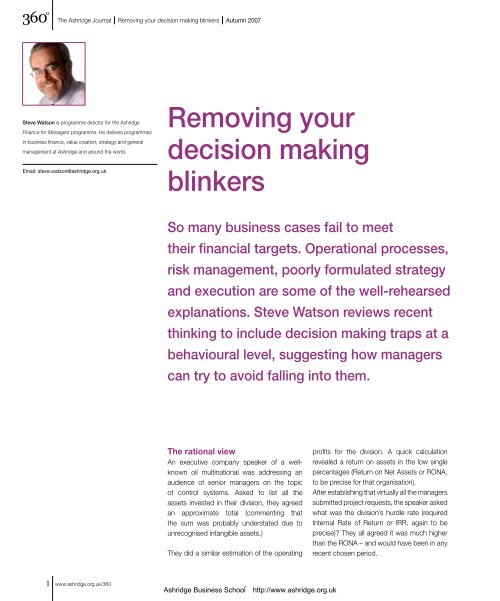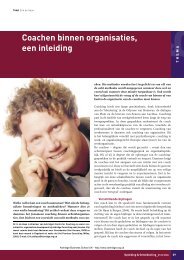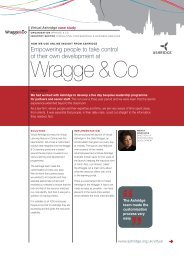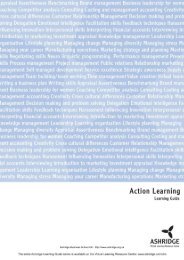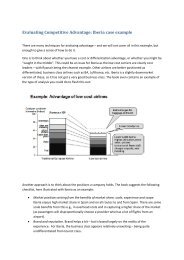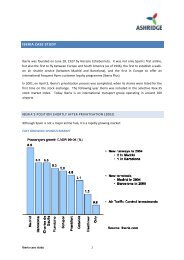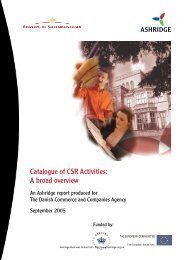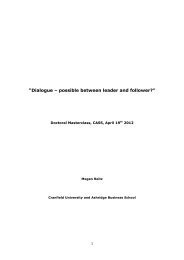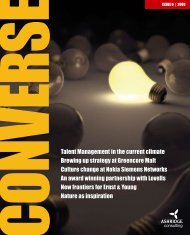Removing your decision making blinkers - Ashridge
Removing your decision making blinkers - Ashridge
Removing your decision making blinkers - Ashridge
You also want an ePaper? Increase the reach of your titles
YUMPU automatically turns print PDFs into web optimized ePapers that Google loves.
Steve Watson is programme director for the <strong>Ashridge</strong><br />
Finance for Managers programme. He delivers programmes<br />
in business finance, value creation, strategy and general<br />
management at <strong>Ashridge</strong> and around the world.<br />
Email: steve.watson@ashridge.org.uk<br />
1<br />
The <strong>Ashridge</strong> Journal <strong>Removing</strong> <strong>your</strong> <strong>decision</strong> <strong>making</strong> <strong>blinkers</strong> Autumn 2007<br />
www.ashridge.org.uk/360<br />
<strong>Removing</strong> <strong>your</strong><br />
<strong>decision</strong> <strong>making</strong><br />
<strong>blinkers</strong><br />
So many business cases fail to meet<br />
their financial targets. Operational processes,<br />
risk management, poorly formulated strategy<br />
and execution are some of the well-rehearsed<br />
explanations. Steve Watson reviews recent<br />
thinking to include <strong>decision</strong> <strong>making</strong> traps at a<br />
behavioural level, suggesting how managers<br />
can try to avoid falling into them.<br />
The rational view<br />
An executive company speaker of a wellknown<br />
oil multinational was addressing an<br />
audience of senior managers on the topic<br />
of control systems. Asked to list all the<br />
assets invested in their division, they agreed<br />
an approximate total (commenting that<br />
the sum was probably understated due to<br />
unrecognised intangible assets.)<br />
They did a similar estimation of the operating<br />
<strong>Ashridge</strong> Business School http://www.ashridge.org.uk<br />
profits for the division. A quick calculation<br />
revealed a return on assets in the low single<br />
percentages (Return on Net Assets or RONA,<br />
to be precise for that organisation).<br />
After establishing that virtually all the managers<br />
submitted project requests, the speaker asked<br />
what was the division’s hurdle rate (required<br />
Internal Rate of Return or IRR, again to be<br />
precise)? They all agreed it was much higher<br />
than the RONA – and would have been in any<br />
recent chosen period.
“So,” he went on, “how many of you submitted<br />
requests that were below the hurdle rate?”<br />
They all agreed that the request would have<br />
been refused if they had. The remainder of the<br />
discussion was usefully spent listing reasons<br />
why they imagined so many failed to match<br />
expectations. The list they came up with was<br />
grouped into a few familiar clusters:<br />
Performance<br />
A small – and honest – group suggested<br />
that they had just not performed well<br />
enough collectively in executing their<br />
plans.<br />
Competitive situation<br />
For others it was a case that the<br />
competitive situation changed, impacting<br />
pricing or volume assumptions of<br />
revenues or costs.<br />
Non-profit-<strong>making</strong> assets<br />
Some non-profit-<strong>making</strong> assets (safety,<br />
head office, etc) do not generate returns<br />
so they drag down the average.<br />
Accounting differences<br />
The bases for calculating profits<br />
and net assets and thus the RONA,<br />
are different from those underlying<br />
the IRR. Most felt that over time<br />
they should expect some form of<br />
correlation between IRR and RONA.<br />
Actually those particularly familiar with the<br />
mechanics believed that the accounting<br />
differences would in fact be more likely<br />
to overstate the RONA – thereby <strong>making</strong><br />
the undershoot worse.<br />
Risk<br />
Some investments are riskier than others<br />
– this is not reflected in the hurdle rate.<br />
Inheritance<br />
Many projects are long term in their nature<br />
and therefore the results of today are due<br />
to poor <strong>decision</strong>s of their predecessors.<br />
(This was a popular cluster – although the<br />
executive pointed out that it was his own<br />
peer group that made up the majority of<br />
predecessors!)<br />
Autumn 2007 <strong>Removing</strong> <strong>your</strong> <strong>decision</strong> <strong>making</strong> <strong>blinkers</strong> The <strong>Ashridge</strong> Journal<br />
Systems and processes<br />
The processes were in some way not<br />
effective or complete. Many managers<br />
did not fully understand the complexity<br />
of the request process and some who<br />
did, complained that the hurdle rate was<br />
set too high.<br />
Predictive limitations<br />
In the last group was a contingent who<br />
made the point that most of the time they<br />
were not in full possession of all the facts<br />
and – to paraphrase Mark Twain, Samuel<br />
Goldwyn and others – that it is difficult<br />
predicting the future. While this raised<br />
a small laugh when they confessed it,<br />
with a little preparation they could have<br />
made reference to a concept introduced<br />
by one of the business world’s most<br />
respected thinkers.<br />
Bounded rationality<br />
Many years ago Professor Herbert Simon<br />
coined the phrase “bounded rationality.” 1 Our<br />
ability to make business <strong>decision</strong>s is bounded<br />
or limited by the “cost” of all the information,<br />
uncertainty and <strong>decision</strong> complexity. In order<br />
to make some kind of progress, we need to<br />
take <strong>decision</strong>s without all the facts. In fact a<br />
study of prediction success by horse racing<br />
handicappers by Russo and Schoemaker 2<br />
showed that as more data was provided<br />
their confidence rose while their performance<br />
peaked and then fell.<br />
In recent years the limits of rationality have<br />
been explored further with a number of<br />
studies such as Prospect Theory 3 . Some<br />
studies have even used advances in brain<br />
scanning technology to develop early patterns<br />
in <strong>decision</strong> <strong>making</strong> observations, known<br />
as neuroeconomics.<br />
So while the above is undoubtedly true as a<br />
checklist for most of the “rational” reasons<br />
that projects and business cases fail to meet<br />
their financial goals, it would be wise to be alert<br />
to some common behavioural phenomena<br />
that may help make sense of the occasions<br />
when logic just can’t provide all the answers.<br />
<strong>Ashridge</strong> Business School http://www.ashridge.org.uk<br />
www.ashridge.org.uk/360 2
3<br />
The <strong>Ashridge</strong> Journal <strong>Removing</strong> <strong>your</strong> <strong>decision</strong> <strong>making</strong> <strong>blinkers</strong> Autumn 2007<br />
www.ashridge.org.uk/360<br />
Know <strong>your</strong>self<br />
Your own thinking and that of those around<br />
you may be subject to the unconscious bias<br />
identified in Prospect Theory. Otherwise<br />
known as Behavioural Economics or<br />
Behavioural Finance, the theory challenges<br />
the basic assumption that economic agents<br />
(that’s you and me) always make rational choices.<br />
Some of the key observations are:<br />
We are more likely to be loss averse<br />
than risk averse.<br />
People tend to take greater risks to avoid<br />
losses than to attain equivalent gains. Some<br />
estimates reckon this is in the order of 2 or<br />
2.5-to-1. Investors for example will often hold<br />
onto loss-<strong>making</strong> shares where all evidence<br />
suggests they will lose more value, while<br />
selling successful ones that are poised to<br />
keep or grow their value.<br />
Key questions: Can you compensate for<br />
<strong>your</strong> personal loss aversion – and that of <strong>your</strong><br />
team? Could <strong>your</strong> business cases generate<br />
a higher average return if you tolerated more<br />
manageable losses in order to gain some<br />
greater wins?<br />
We are likely to be unwittingly<br />
selective in the information we use to<br />
make a case.<br />
People tend to give higher priority to recent<br />
information over more complete, better quality<br />
older data. Precedence is given to information<br />
that appeals to our preconceptions and not to<br />
that which challenges them.<br />
Key questions: Is there a chance you are<br />
skewing data selectively? Could you benefit<br />
from a “devil’s advocate”? Can you develop<br />
the ability to play this role adequately<br />
<strong>your</strong>self?<br />
We are prone to attach ourselves to<br />
“anchors”.<br />
People will often use reference points<br />
(in extreme cases arbitrary ones) to test the<br />
validity of information. It may be the first figure<br />
suggested in a negotiation, the last trading<br />
price of a share, or the most recent quarterly<br />
earnings of a company.<br />
<strong>Ashridge</strong> Business School http://www.ashridge.org.uk<br />
Key questions: Is part of <strong>your</strong> thinking<br />
attached to an anchor? Can you develop a<br />
form of “zero-based thinking”? Do you judge<br />
cases by what is “practical” or “realistic”<br />
rather than what is “possible”?<br />
We tend to subordinate wisdom<br />
about the future to the emotion of the<br />
present.<br />
Research, for example by Laibson 4 , has<br />
shown that different parts of the brain<br />
deal with <strong>decision</strong>s affecting the long<br />
term and the immediate. When people<br />
are contemplating the distant future, the<br />
prefrontal cortex is active, suggesting a<br />
relatively more rational process – even if by<br />
definition not a perfect or complete process.<br />
When the <strong>decision</strong> is about more immediate<br />
effects, the more emotionally driven limbic<br />
system can overwhelm the thinking and<br />
reduce the benefit of usually more complete<br />
data. As Thomas Schelling 5 pointed out:<br />
“People often behave like two people...<br />
one who wants a lean body and the other<br />
who wants dessert.” A survey quoted in<br />
The Economist 6 found that well over half of<br />
the chief financial officers questioned said<br />
they would cut a value-creating investment<br />
rather than miss an earnings target set by<br />
the market. Dessert today instead of lean<br />
body tomorrow!<br />
Key questions: Can you identify any<br />
difference in <strong>your</strong> thinking between the short<br />
and long term? Do you allow reflection time<br />
– personally and collectively – for dealing<br />
with <strong>decision</strong>s with a recognisably short<br />
term response – for example the glory of<br />
winning the contract over the more long<br />
term suitability of delivering it profitably?<br />
Self-interest and bias unconsciously<br />
impacts our <strong>decision</strong> <strong>making</strong> to a<br />
great extent.<br />
Studies, for example by Bazerman and<br />
Malhotra 7 , and Bazerman et al 8 , have<br />
shown that we are often unaware of how<br />
our personal self-interest drives our<br />
<strong>decision</strong>s without our conscious recognition.<br />
We kid ourselves more than we think!
It even applies when we are acting as agents<br />
for a third party – we will not see how our<br />
<strong>decision</strong>s are biased in their favour.<br />
Key questions: Can you develop <strong>your</strong> (and<br />
<strong>your</strong> team’s) self awareness to recognise<br />
self-interest traps? Can you develop systems<br />
and rewards to be more congruent?<br />
Know <strong>your</strong> colleagues<br />
Once you have done <strong>your</strong> best to clear<br />
<strong>your</strong> own thinking of unconscious bias, you<br />
may want to consider how others involved<br />
in the <strong>decision</strong> may behave. Logically you<br />
would like to believe that they too want<br />
the rationally best solution, although they<br />
too will be subject to the same influences<br />
as above.<br />
Game theory (as developed by such<br />
authors as Neumann, Blinder, Nash and<br />
Axelrod) looks to account for the reactions<br />
of others, usually competitive “players”. The<br />
best known examples are the Prisoners’<br />
Dilemma and the Ultimatum Game.<br />
Prisoners’ Dilemma is where two<br />
prisoners have to choose between<br />
cooperating with the authorities<br />
(confessing) and not confessing. One<br />
variation of the dilemma has it that if<br />
only one confesses, that one goes free<br />
(and the other gets ten years); if both<br />
confess, each gets seven years; and<br />
if neither confesses, they both get one<br />
year. Evidence suggests that the most<br />
common response as a strategy is to<br />
confess, even though the “best” result<br />
(in total for both players) would be to<br />
keep quiet.<br />
The Ultimatum Game 9 is a simple<br />
experiment where two parties split<br />
a set sum. Player A offers a split<br />
and B can either agree or reject.<br />
If the latter, then neither gets anything.<br />
Countless experiments show that if the<br />
offer is perceived to be too small and<br />
unfair, B will tend to reject.<br />
Autumn 2007 <strong>Removing</strong> <strong>your</strong> <strong>decision</strong> <strong>making</strong> <strong>blinkers</strong> The <strong>Ashridge</strong> Journal<br />
Extending this principle to business<br />
<strong>decision</strong>s illustrates why many worthwhile<br />
cases that rely on cooperation between<br />
parties might fail. Two mechanisms exist to<br />
correct for this. One is to have some kind of<br />
enforcement (the Mafia law of “Omerta” may<br />
keep you from confessing in the Prisoners’<br />
Dilemma, while rules, regulations, leadership,<br />
are some of the equivalents in organisations<br />
and economies). The other mechanism is<br />
when the dilemma is posed more than one<br />
time and players find themselves punished<br />
in subsequent rounds. The organisational<br />
equivalent can be found when managers<br />
feel that they may need to cooperate today<br />
in order to ensure that others will cooperate<br />
in the future with them when they need it.<br />
The principles behind the Prisoners’<br />
Dilemma and the Ultimatum Game provide a<br />
good example of participants endeavouring<br />
to balance collective benefit with personal<br />
benefit. At one level focusing on narrow self<br />
interest can be seen to be a form of rational<br />
process – even if it is difficult to judge all<br />
the payoffs in reality – and lies behind the<br />
dark side of corporate politics. However<br />
there are many examples of sub-optimal<br />
overall solutions resulting from self-centred<br />
actions. They are the corporate equivalent<br />
of the driver who hugs the “fast lane” for<br />
personal comfort, driving below the speed<br />
limit – other, possibly faster, cars could<br />
be prevented from passing them and the<br />
overall result is a slower traffic flow.<br />
An example is given in the book<br />
Freakonomics 10 . A day-care centre in Israel<br />
was experiencing problems with parents<br />
arriving late to collect their children at the<br />
correct deadline. They decided that they<br />
needed to introduce a system to incentivise<br />
a change in their behaviours – they<br />
introduced a $3 fine for each incident (of<br />
more than ten minutes late) to be added to<br />
their monthly bill. When the centre evaluated<br />
the impact of the scheme after 20 weeks,<br />
they found that behaviours had changed.<br />
Parents were on average even later! The $3<br />
was not seen as a punishment, it was too<br />
small a deterrent. It served partly to assuage<br />
<strong>Ashridge</strong> Business School http://www.ashridge.org.uk<br />
www.ashridge.org.uk/360 4
The <strong>Ashridge</strong> Journal <strong>Removing</strong> <strong>your</strong> <strong>decision</strong> <strong>making</strong> <strong>blinkers</strong> Autumn 2007<br />
the parent’s guilt and was also perceived<br />
as a very cheap babysitting fee. The value<br />
of the payoffs and penalties need to be<br />
set appropriately.<br />
Key questions: Are people’s schemes and<br />
actions serving to meet the organisational<br />
goals or their own? Are most of <strong>your</strong> rules<br />
and systems designed to stop people doing<br />
something wrong (expense claims) or to help<br />
them do good (service level responses)?<br />
Have you correctly valued the payoffs and<br />
penalties?<br />
Know <strong>your</strong> organisation: draw on<br />
the Wisdom of Crowds<br />
So, you’ve reflected on the key questions<br />
above and still want more. What else can<br />
you do to avoid the behavioural traps of<br />
<strong>decision</strong> <strong>making</strong>? The answer may be to<br />
draw on the “wisdom of crowds” 11 , another<br />
area attracting recent attention. Could <strong>your</strong><br />
<strong>decision</strong>s be improved by opening them up<br />
to a broader audience?<br />
In 1986 within minutes of the space<br />
shuttle Challenger blowing up, the<br />
stock market had marked down the<br />
shares of the companies adversely<br />
impacted, particularly Morton Thiokol<br />
which was found six months later in the<br />
findings of a Presidential Commission<br />
to have supplied the faulty seals on the<br />
booster rockets.<br />
This and other examples show the<br />
power of collective <strong>decision</strong> <strong>making</strong><br />
– the “wisdom of crowds”. It suggests<br />
that while an organisation in its collective<br />
form has the capacity to perform or at<br />
least condone irrational, and in many<br />
cases, unethical acts 12 , under the<br />
right conditions and for certain types<br />
of clearly expressed options, opening<br />
up the <strong>decision</strong> to a wider group can<br />
unleash the capability to make better<br />
<strong>decision</strong>s than individuals or small<br />
groups within it may make.<br />
5<br />
www.ashridge.org.uk/360<br />
The trick, it would seem, is to ensure that the<br />
“crowd” or group is diverse, decentralised<br />
and independent with an effective and<br />
transparent means of aggregating its<br />
members’ ideas and inputs.<br />
In practice many organisations’ attempts<br />
to collective <strong>decision</strong> <strong>making</strong> is less than<br />
effective as they find themselves adopting<br />
a form of groupthink or trying to secondguess<br />
the views of key players in the<br />
firm. It can be difficult in complex political<br />
hierarchies to access genuine diversity.<br />
Another danger was pointed out in 1785 by<br />
the Marquis de Condorcet as he explored<br />
the degree of success in the French jury<br />
system of the time. His theory was that if<br />
the average probability of each individual<br />
in the jury/group getting the judgement/<br />
<strong>decision</strong> correct was greater than 50%,<br />
the probability of the group <strong>making</strong> the<br />
right <strong>decision</strong> approaches 100% as the<br />
group gets bigger. However if the average<br />
individual probability was less than 50%,<br />
the group’s <strong>decision</strong> would get less and less<br />
likely to be right. So diversity needs to be<br />
balanced with some degree of qualification<br />
and insight, it would seem.<br />
Key questions: Is <strong>your</strong> organisation able<br />
to tap into the potential of its people? Is<br />
there a culture of diversity, independence,<br />
transparency?<br />
Our increasing knowledge of behavioural<br />
economics and its impact on financial<br />
<strong>decision</strong> <strong>making</strong> should focus managers’<br />
attention on a wider range of factors<br />
at work in determining whether their<br />
businesses meet their financial targets.<br />
Awareness of one’s own tendencies, those<br />
of colleagues and the wider organisation<br />
– maybe addressed with the help of the key<br />
questions above – will be a good start on<br />
the way to removing managers’ <strong>decision</strong><br />
<strong>making</strong> <strong>blinkers</strong>.<br />
References<br />
1. Simon H.A. (1996) Models of My Life,<br />
The MIT Press.<br />
2. Russo J.E. and Schoemaker P.J.H. (2002)<br />
Winning Decisions: Getting It Right the First Time,<br />
Piatkus Books.<br />
3. Kahneman D. and Tversky A. (1979) Prospect<br />
Theory: an Analysis of Decisions under Risk,<br />
Econometrica, 47.<br />
4. Laibson D.I. (1997) Golden Eggs and Hyperbolic<br />
Discounting, Quarterly Journal of Economics.<br />
5. Schelling T. (1978) Ergonomics, or the Art of Self<br />
Management, The American Economic Review, 98.<br />
6. The Economist (2007) Report on Executive Pay,<br />
20 January.<br />
7. Bazerman M.H. and Malhotra D. (2006) When Not to<br />
Trust Your Gut, HBS Working Knowledge, May.<br />
8. Bazerman M.H., Loewenstein G. and Moore D.A.<br />
(2002) Why Good Accountants Do Bad Audits, Harvard<br />
Business Review, November.<br />
9. Guth W., Schmittberger R. and Schwarze B. (1982)<br />
An Experimental Analysis of Ultimatum Bargaining,<br />
Journal of Economic Behavior and Organization, 3.<br />
10. Levitt S. and Dubner S. (2006) Freakonomics:<br />
a Rogue Economist Explores the Hidden Side of<br />
Everything. Penguin Books.<br />
11. Surowiecki J. (2005) The Wisdom of Crowds,<br />
Abacus.<br />
12. Bakan J. (2005) The Corporation: The Pathological<br />
Pursuit of Profit and Power, Constable and Robinson.<br />
Further reading<br />
1. Hammond J., Keeney R. and Raiffa H. (2006)<br />
The Hidden Traps in Decision Making, Harvard<br />
Business Review, January.<br />
2. Mauboissin M.J.(2006) More Than You Know:<br />
Finding Financial Wisdom in Unconventional Places,<br />
Columbia University Press.<br />
3. Harford T. (2006) The Undercover Economist,<br />
Little, Brown.<br />
<strong>Ashridge</strong> Business School http://www.ashridge.org.uk<br />
4. Brafman O. and Beckstrom R.A. (2007) The Starfish<br />
and Spider: The Unstoppable Power of Leaderless<br />
Organizations, Portfolio.


